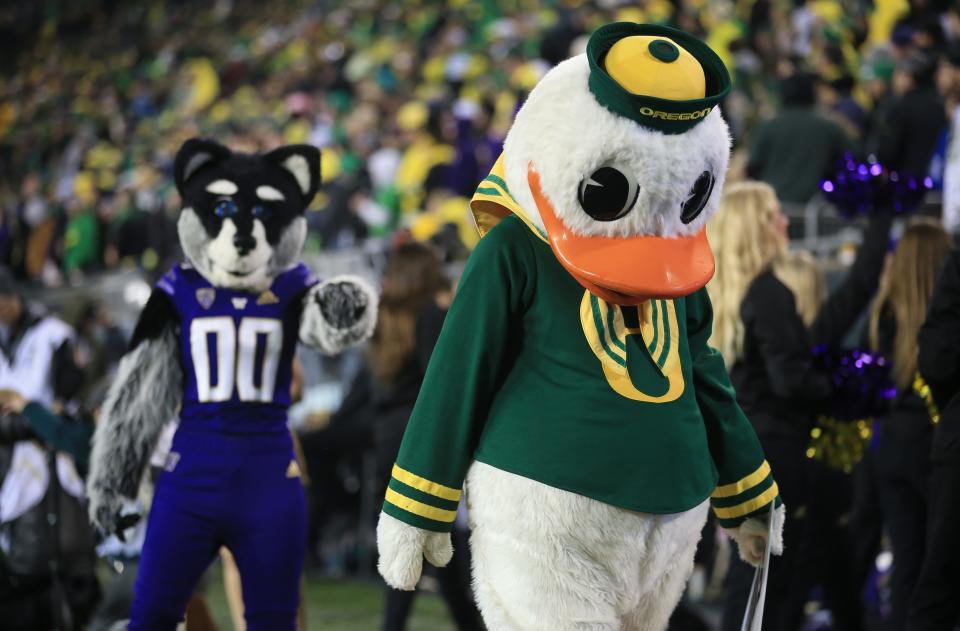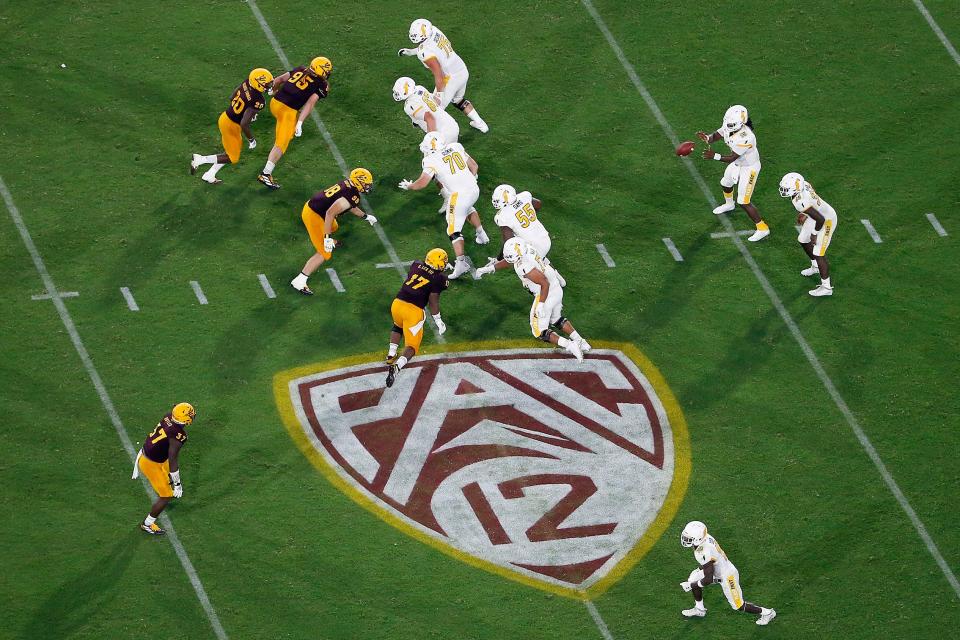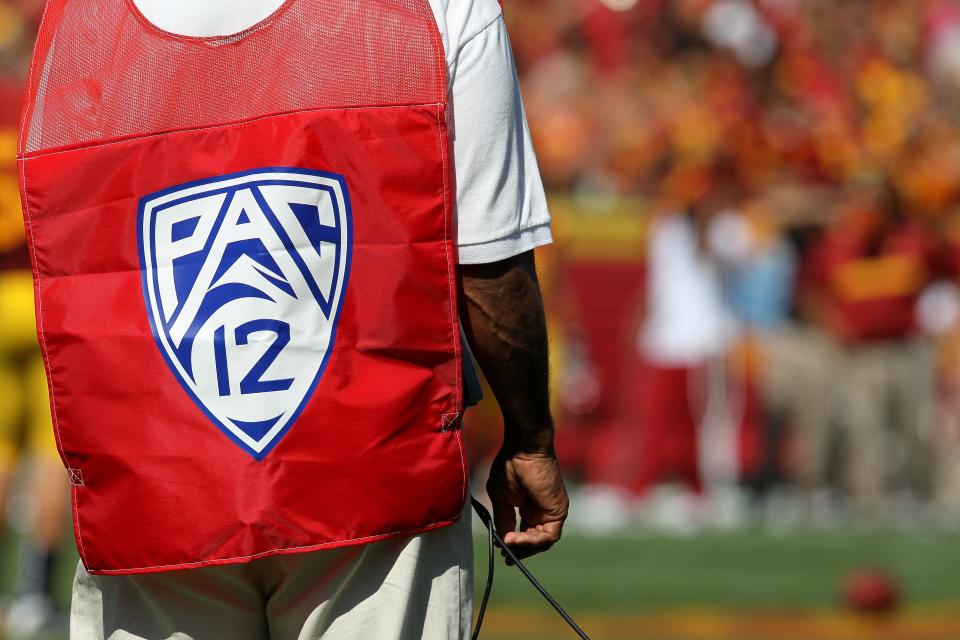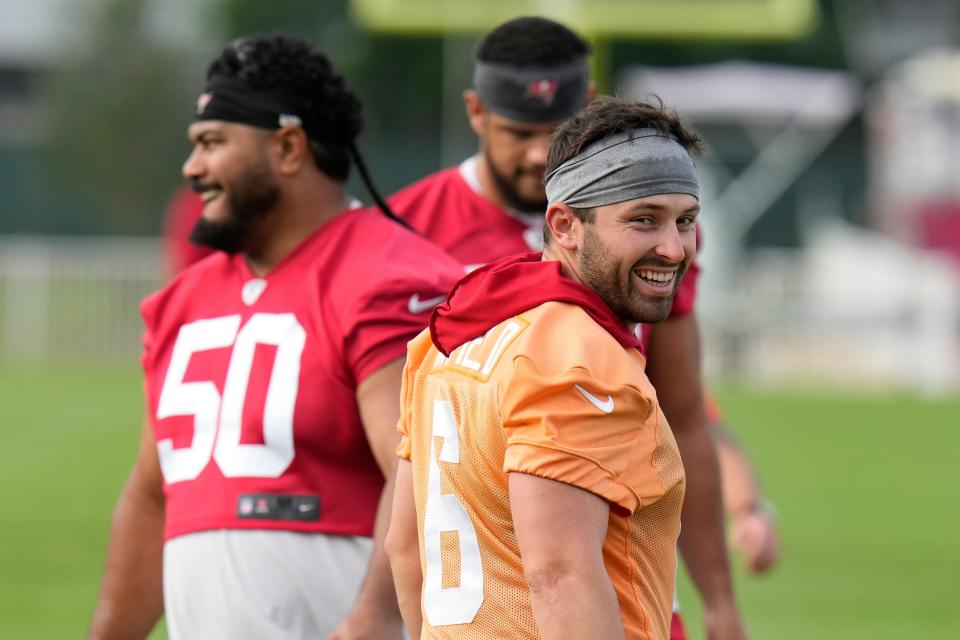Tramel's ScissorTales: Pac-12 Conference's demise is a sad day in collegiate athletics
Friday was a sad day for college football.
Friday likely was a potential victorious day for the Big 12, with apparently Arizona and perhaps Arizona State and Utah coming to the conference.
Friday was a fascinating day for the Big Ten, with Washington and Oregon receiving invitations to join the league of Rutgers and Maryland.
Friday was a disastrous day for the Pac-12, Bill Walton’s conference of champions, with the loss of its last two remaining cornerstones and perhaps more.
The latter brings the sadness.
If the bell tolls for the Pac-12, or even the Pac-12 as we once knew it, college athletics are worse, not better.
More: Tramel's ScissorTales: Pac-12 commissioner didn't follow Bob Bowlsby's Big 12 blueprint

Losing a regal conference is not good for anybody. It perhaps helps the Big Ten with a little more geographic balance, what with Southern Cal and UCLA already set to join the league. It absolutely helps the Big 12 with stability; a league twice on life support is breathing on its own.
But a dead Pac-12, or a zombie Pac-12, with half-Mountain West schools, makes college football a lesser product.
A grand sport with a wild mix of schools and traditions and styles and kickoff times, has become more homogenized. More corporate.
More corporate never is a good thing.
College football tradition is matched by what other sport? Baseball maybe. Certainly not the National Football League. Not the NBA. Not college basketball. Not even golf, which at times can be stuck in 1963.
Grand old rivalries. Kooky trophies. Iconic uniforms. Wild formations and schemes.
All are part of college football’s fabric, yet some have been whittled and others are in danger, as conference realignment changes the landscape.
Death of a conference usually is sad.
But when Big East football died, we at least knew Big East basketball would live on, no doubt thrive, and it wasn’t like Big East football dominated our pasts or our presents.
And when the Southwest Conference died, we knew it was a one-state league, which made sense in its day and was quaint by modern standards, but really didn’t work as the 21st century loomed.
More: Tramel's ScissorTales: Arizona, Utah & Arizona State decisions take Pac-12 to the brink

But the Pac-12? The conference of John Wooden and Marcus Allen, the conference of Mel Renfro and Sonny Sixkiller, the conference of John Elway and Jim Plunkett?
How could a league with so much history and so much tradition and so much style, a league that was the NCAA’s front porch for literally two American time zones, go out of business or be a virtual museum relic?
Well, we know the answer. Inexplicably terrible leadership. Corporate greed from infidels. A changing marketplace. Academic arrogance. Plenty of blame to go around.
Who killed the Pac-12 as we know it? Round up the usual suspects. Former Pac-12 commissioner Larry Scott. USC, with its decision to bolt for the Big Ten. Current Pac-12 commissioner George Kliavkoff. The Southeastern Conference, for lighting the latest realignment surge by swiping OU and Texas from the Big 12. The Big Ten, for feigning an alliance with the Pac-12, then stabbling the Pac in the back. Brutus and Judas had nothing on former Big Ten commissioner Kevin Warren.
Doesn’t much matter now.
The Pac-12 figures to die a quick death, or reinvent itself as a half-power league. Stanford and Cal-Berkeley have wanted nothing to do with Boise State for lo these many years; now the likes of Boise State are all that could keep a Pac-12 0.0 alive.
And various Western ports will be a little (or a lot) less interested in college football.
The metrics say that doesn’t matter to the bottom line. Oregon State and Washington State don’t produce huge numbers in the marketplace. The Bay Area is not a college sports hotbed.
And in recent years, the Pac-12 became less relevant at the highest levels of competition. No College Football Playoff team since 2016. No NCAA basketball title since 1997.
But the Pac-12 has been distinct. Provincial.
More: ESPN, Fox pull strings of college athletics realignment that overlooks tradition or merit

The league was different, in ways beyond television money. It’s like Walton said when his Bruins declared for the Big Ten: “I don’t want to join the Big Ten, I want to beat the Big Ten.”
Conference superiority, conference pride, once was a rallying point for fans.
A week or two after OU and Texas declared for the SEC in 2021, I stopped off in Mississippi en route to the Alabama gulf coast. I ran into an OU fan, and he was bummed by the SEC news.
He said he will miss the arguments and the debates over conferences. Standing in SEC country, on vacation from Edmond, he seemed to want to beat the SEC, not join the SEC.
Rivalries between conferences has invigorated fans. SEC vs. ACC. Big Ten vs. Pac-12. Big 12 vs. SEC. ACC vs. Big Ten. Big 12 vs. Pac-12.
But soon there could be just four major conferences, with clear delination in that small club. SEC and Big Ten on one side, Big 12 and ACC on the other.
The Pac-12's troubles have propped up the Big 12, and that’s good news in Ames and Manhattan, Lubbock and Stillwater.
But it’s not good news for the health of the sport, which built its popularity on tradition but now is turning its back to the same.
More: Tramel: Pac-12 arrogance helped save the Big 12 two years ago and now has league in peril
Blackburn writes Twin Hills history
The story of Twin Hills starts with the land.
That is true from the perspective of Bob Blackburn, the Oklahoma historian who has penned a book celebrating the golf club’s centennial.
It’s also true of Oklahoma legend Perry Maxwell, the golf-course architect who laid out Twin Hills 100 years ago.
“When people first see Twins Hills Golf and Country Club, their eyes are magically drawn to the beauty of a hilly, rolling landscape with ribbons of green grass carved from a thick forest of trees,” Blackburn writes to begin his book.
“For the men and women who enjoy golf, those same hills, valleys and trees create a unique challenge to test their skills no matter how many rounds they have played or what handicap they have earned. Both the beauty and the challenge begin with the land.”
Most of us have seen the land, if for no other reason than most of us have driven Interstate 35, just north of Northeast 36th Street. Lincoln Park, the iconic public course, sits on the elevated west side of the freeway. The regal Twin Hills sits in the valley to the east.
Blackburn, the retired executive director of the Oklahoma Historical Society, has played Twin Hills often. But before writing, Blackburn walked the course, trying to retrace the steps of Maxwell a century ago.
“You can see what Perry Maxwell saw when he walked that land,” Blackburn said.
Maxwell is the famed architect of more than 70 layouts, including Tulsa’s Southern Hills, which has hosted either the U.S. Open or the PGA Championship eight times; Ardmore’s Dornick Hills; and the original OU course. Maxwell was a co-designer of Colonial in Fort Worth, Texas; Prairie Dunes in Hutchinson, Kansas; and Oklahoma City Golf & Country Club.
And in 1923, a 44-year-old Maxwell, with a variety of golf courses already on his résumé, bought farmland about two miles northeast of the closest housing additions in Oklahoma City.
By 1935, Twins Hill was hosting the PGA, won by Johnny Revolta, who beat the legendary Walter Hagen in the first round of match play.
The likes of Hagen, Ben Hogan and Arnold Palmer hailed Twin Hills over the years.
Blackburn identifies the African-American farmer, Robert Boyd, who worked the land before selling it to Maxwell.
Blackburn writes of Dorset Carter, father of Oklahoma City teen-age sensation Keefe Carter, 1925 winner of the prestgious Western Amateur. Dorset Carter bought Twin Hills from Maxwell in ‘25.
And Blackburn details the star-studded cast, from Gene Sarazen to Hagen to Tommy Armour, that competed in the 1935 PGA.
Blackburn donates a full chapter to Palmer, who won the 1959 Oklahoma City Open at Twin Hills and returned the next year only to lose a final-round shootout with Gene Littler.
“People don’t understand his appeal,” said Blackburn, who remembers as a boy watching Palmer play by crouching between the legs of adults. “He was like Mickey Mantle. A blond demigod, with the ability to be humble and charismatic. When he talked, he was so honest. He loved Twin Hills.”
Twin Hills doesn’t host professional tournaments anymore. The infrastructure and space required for modern golf tournaments don’t exist at Twin Hills, with a city grown up around it.
But the beauty remains. The beauty and the land, which Maxwell saw a century ago, which we see fleetingly zipping along I-35 and which Blackburn has captured with his book.
Twin Hills: A Centennial History is available at Full Circle Books and the Oklahoma History Center.
“The history of Twins Hills is full of colorful characters and cliffhanging challenges set against the backdrop of Oklahoma’s boom and bust economy and America’s love affair with golf,” touts the inside cover of the book’s jacket. “Each story, each twist and turn in the narrative, leads the reader to a final conclusion. Twins Hills is a special place with a unique history.”
More: Tramel's ScissorTales: Expanded Big 12 will make 12-team playoff even harder to reach
De’Angelo Russell lauds Shai Gilgeous-Alexander
The Lakers’ De’Angelo Russell hailed Thunder star Shai Gilgeous-Alexander on the most recent Pat Beverley podcast.
“Shai’s the most underrated player in the league, bro,” Russell said to Beverley, the mercurial guard now with the Philadelphia 76ers. “I remember, you said it. You’re like, ‘He got that Kobe (stuff).’
“When people say the most underrated player in the league, every year I think of somebody else that’s just like nobody’s talking about. Shai’s the most underrated, hardest player to guard in the league.
“Ask Pat. Listen, OKC do this thing off the free-throw line where we shoot the free throw, Shai’s at the free-throw line, and they put all the other guys in the corner. And it’s a full court, one-on-one guarding Shai. They do it every game, all game, and you still can’t stop it. Not halfcourt. Free-throw line. Bring it up, get to it. He unguardable.”
Rone, co-host of the podcast with Beverley, said, “The stats prove it. But I think he kind of gets lost, he winds up in that no-man's land in terms of media coverage. But as the Nuggets proved this year, you can kind of win that (stuff). They have a nice young squad out there.”
Russell said, “They gone be good.”
Our man Joe Mussatto wrote about the foul-line play that Russell referenced. It is quite ingenious. And it works especially well with a player like Gilgeous-Alexander.
More: OKC Thunder announces 2023 NBA preseason schedule, will open vs. Victor Wembanyama, Spurs
Mailbag: Utah-BYU rivalry
Who knows how conference realignment will shake out, but the desires of each individual school is fascinating.
David: “I know Oregon and Washington would jump to the Big Ten if given the opportunity. What is Utah thinking? Just a little cat and mouse? I would love to add Utah to the Big 12. Rumors have it they won't even return Big 12 calls. Is there a BYU/Utah conflict? I guess Oregon and Washington leaving the Pac-9 might persuade Utah to join the Big 12.”
Tramel: Yes, Utah and Brigham Young have a conflict. From the time BYU became football relevant in the 1970s until 2011, Utah was the little brother. Then Utah joined the Pac-12, BYU went independent and fortunes changed. The Utes soon enough became the big brother. And enjoyed that status.
Now, BYU is Big 12-bound, and the Utes don't want to be seen as following BYU. Utah will join the Big 12 only if it has to.
More: Tramel: BYU leads the celebrations as Big 12 Conference enters new era

The List: NFL quarterback battles
One of the few interesting things about football training camps are quarteback competitions. Most teams don’t have a derby, even if coaches proclaim the job is open.
The National Football League appears to have open competitions for QB jobs this August:
1. Tampa Bay: Baker Mayfield vs. Kyle Trask. Expect Mayfield to be the starter, unless the Buccaneers go into tank mode, which won’t be easy to do, since this is a veteran roster.
2. Indianapolis: Anthony Richardson vs. Gardner Minshew. Colts owner Jim Irsay already has labeled the rookie Richardson a likely starter sometime in the 2023 season, but Minshew knows the system, having come over from the Eagles with new Colts head coach Shane Steichen.
3. Washington: Sam Howell vs. Jacoby Brissett. Howell made one start a year ago, and the Commanders were impressed enough to not add anyone north of Brissett, a longtime backup who has been solid in periodic starts with Miami, Cleveland and Indy. Howell probably is the guy.
4. San Francisco: Brock Purdy vs. Trey Lance vs. Sam Darnold. You would think this is Purdy’s job, after his rise from third-team rookie to taking the 49ers to the NFC Championship Game. But Purdy might not be healthy enough to start the season, opening the door for the injury-riddled Lance and the now-veteran Darnold.
5. Jetropolitans. Aaron Rodgers vs. Zach Wilson. Just kidding. A test to see if you’re reading to the end.
Berry Tramel: Berry can be reached at 405-760-8080 or at btramel@oklahoman.com. He can be heard Monday through Friday from 4:40-5:20 p.m. on The Sports Animal radio network, including FM-98.1. Support his work and that of other Oklahoman journalists by purchasing a digital subscription today.
This article originally appeared on Oklahoman: Pac-12 Conference's demise is a sad day in collegiate athletics

